1998 HONDA ODYSSEY tire type
[x] Cancel search: tire typePage 5 of 272
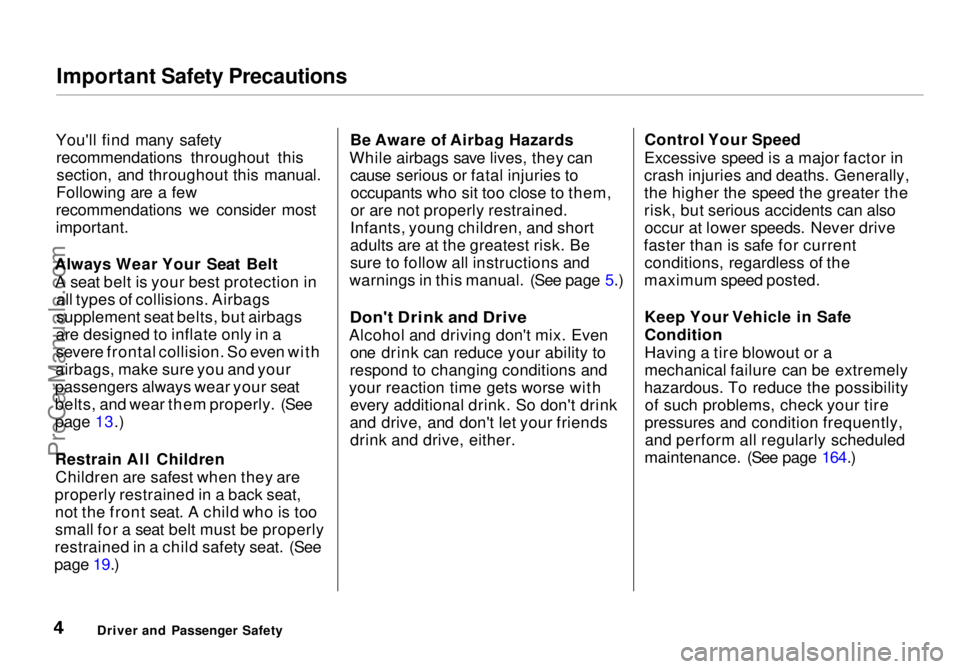
Important Safety Precautions
You'll find many safety recommendations throughout thissection, and throughout this manual.
Following are a few
recommendations we consider most
important.
Always Wear Your Seat Belt A seat belt is your best protection in all types of collisions. Airbags
supplement seat belts, but airbags
are designed to inflate only in a
severe frontal collision. So even with
airbags, make sure you and your
passengers always wear your seat
belts, and wear them properly. (See
page 13.)
Restrain All Children
Children are safest when they are
properly restrained in a back seat, not the front seat. A child who is too
small for a seat belt must be properly
restrained in a child safety seat. (See
page 19.) Be Aware of Airbag Hazards
While airbags save lives, they can cause serious or fatal injuries tooccupants who sit too close to them,
or are not properly restrained.
Infants, young children, and short
adults are at the greatest risk. Be
sure to follow all instructions and
warnings in this manual. (See page 5.)
Don't Drink and Drive
Alcohol and driving don't mix. Even one drink can reduce your ability to
respond to changing conditions and
your reaction time gets worse with every additional drink. So don't drink
and drive, and don't let your friends drink and drive, either. Control Your Speed
Excessive speed is a major factor in
crash injuries and deaths. Generally,
the higher the speed the greater the
risk, but serious accidents can also occur at lower speeds. Never drive
faster than is safe for current conditions, regardless of the
maximum speed posted.
Keep Your Vehicle in Safe
Condition
Having a tire blowout or a
mechanical failure can be extremely
hazardous. To reduce the possibility of such problems, check your tire
pressures and condition frequently, and perform all regularly scheduled
maintenance. (See page 164.)
Driver and Passenger SafetyProCarManuals.comMain Menu Table of Contents s t
Page 195 of 272
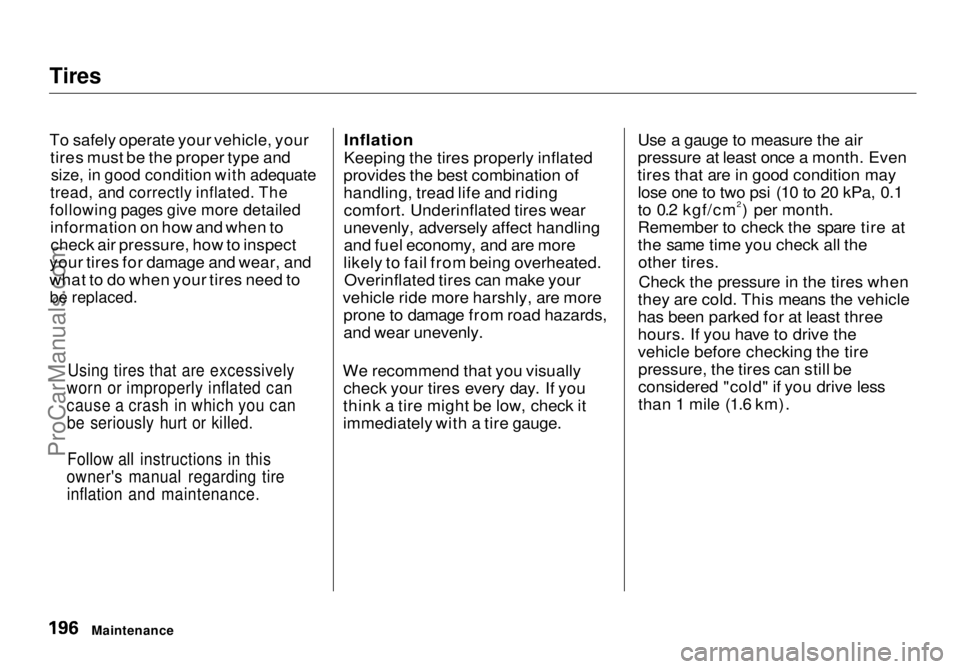
Tires
To safely operate your vehicle, your
tires must be the proper type and
size, in good condition with adequate
tread, and correctly inflated. The
following pages give more detailed
information on how and when tocheck air pressure, how to inspect
your tires for damage and wear, and
what to do when your tires need to
be replaced.
Inflation
Keeping the tires properly inflated
provides the best combination of
handling, tread life and riding comfort. Underinflated tires wear
unevenly, adversely affect handling and fuel economy, and are more
likely to fail from being overheated. Overinflated tires can make your
vehicle ride more harshly, are more prone to damage from road hazards,
and wear unevenly.
We recommend that you visually check your tires every day. If you
think a tire might be low, check it
immediately with a tire gauge. Use a gauge to measure the air
pressure at least once a month. Even
tires that are in good condition may lose one to two psi (10 to 20 kPa, 0.1
to 0.2 kgf/cm2) per month.
Remember to check the spare tire at
the same time you check all theother tires.
Check the pressure in the tires when
they are cold. This means the vehicle
has been parked for at least three
hours. If you have to drive the
vehicle before checking the tire pressure, the tires can still be
considered "cold" if you drive less
than 1 mile (1.6 km).
Maintenance
Using tires that are excessively
worn or improperly inflated can
cause a crash in which you can be seriously hurt or killed.
Follow all instructions in this
owner's manual regarding tire inflation and maintenance.ProCarManuals.comMain Menu Table of Contents s t
Page 199 of 272
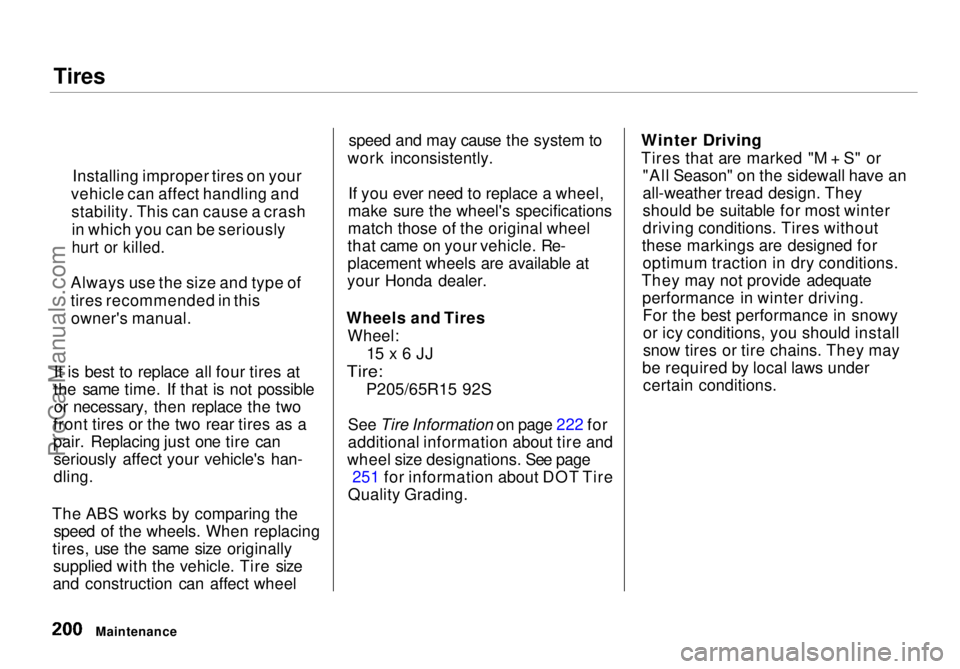
Tires
It is best to replace all four tires at
the same time. If that is not possible or necessary, then replace the two
front tires or the two rear tires as a
pair. Replacing just one tire can seriously affect your vehicle's han-
dling.
The ABS works by comparing the speed of the wheels. When replacing
tires, use the same size originally supplied with the vehicle. Tire size
and construction can affect wheel speed and may cause the system to
work inconsistently.
If you ever need to replace a wheel,
make sure the wheel's specifications
match those of the original wheel
that came on your vehicle. Re-
placement wheels are available at
your Honda dealer.
Wheels and Tires
Wheel:
15 x 6 JJ
Tire:
P205/65R15 92S
See Tire Information on
page 222 for
additional information about tire and
wheel size designations. See page 251 for information about DOT Tire
Quality Grading.
Winter Driving
Tires that are marked "M + S" or
"All Season" on the sidewall have an
all-weather tread design. They
should be suitable for most winter
driving conditions. Tires without
these markings are designed for optimum traction in dry conditions.
They may not provide adequate performance in winter driving.For the best performance in snowyor icy conditions, you should install
snow tires or tire chains. They may
be required by local laws under certain conditions.
Maintenance
Installing improper tires on your
vehicle can affect handling and stability. This can cause a crashin which you can be seriously
hurt or killed.
Always use the size and type of
tires recommended in this owner's manual.ProCarManuals.comMain Menu Table of Contents s t
Page 200 of 272
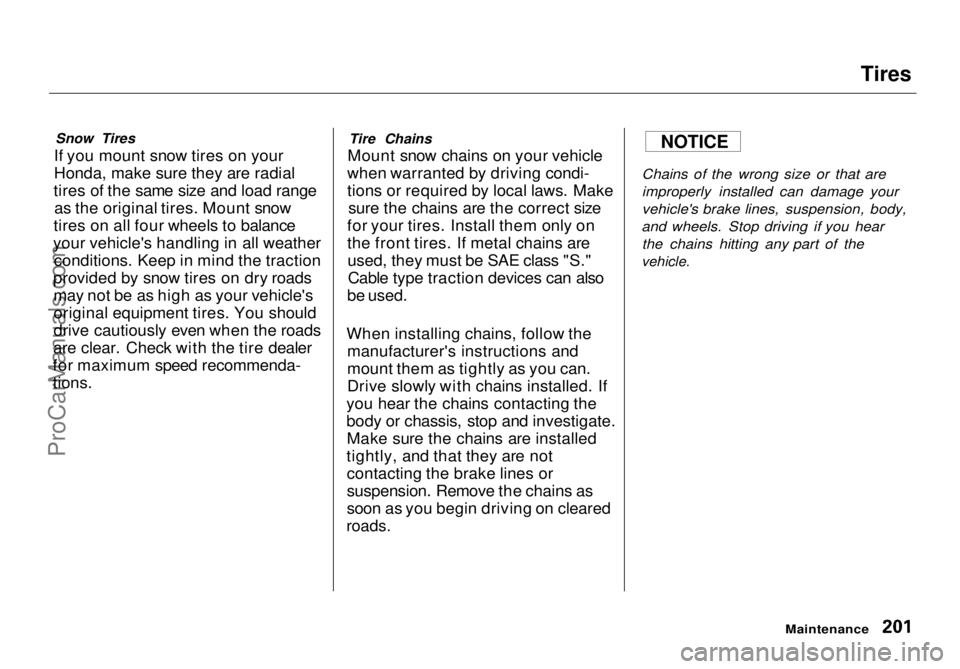
Tires
Snow Tires
If you mount snow tires on your
Honda, make sure they are radial
tires of the same size and load range as the original tires. Mount snow
tires on all four wheels to balance
your vehicle's handling in all weather conditions. Keep in mind the traction
provided by snow tires on dry roads may not be as high as your vehicle's
original equipment tires. You should
drive cautiously even when the roads
are clear. Check with the tire dealer
for maximum speed recommenda-
tions. Tire Chains
Mount snow chains on your vehicle
when warranted by driving condi-
tions or required by local laws. Make sure the chains are the correct size
for your tires. Install them only on
the front tires. If metal chains are used, they must be SAE class "S."Cable type traction devices can also
be used.
When installing chains, follow the manufacturer's instructions and
mount them as tightly as you can.
Drive slowly with chains installed. If
you hear the chains contacting the
body or chassis, stop and investigate. Make sure the chains are installed
tightly, and that they are not contacting the brake lines or
suspension. Remove the chains as
soon as you begin driving on cleared
roads.
Chains of the wrong size or that are
improperly installed can damage your
vehicle's brake lines, suspension, body,
and wheels. Stop driving if you hear
the chains hitting any part of the
vehicle.
Maintenance
NOTICEProCarManuals.comMain Menu Table of Contents s t
Page 241 of 272
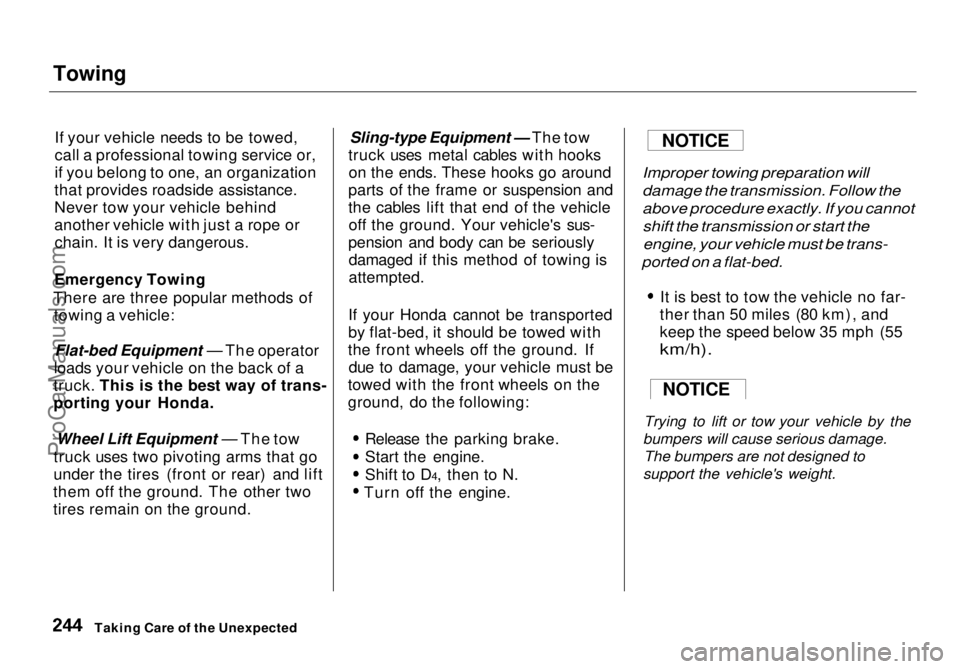
Towing
If your vehicle needs to be towed,
call a professional towing service or,
if you belong to one, an organization
that provides roadside assistance.
Never tow your vehicle behind
another vehicle with just a rope or chain. It is very dangerous.
Emergency Towing
There are three popular methods of towing a vehicle:
Flat-bed Equipment — The operator
loads your vehicle on the back of a
truck. This is the best way of trans-
porting your Honda.
Wheel Lift Equipment — The tow
truck uses two pivoting arms that go
under the tires (front or rear) and lift
them off the ground. The other two
tires remain on the ground.
Sling-type Equipment — The tow
truck uses metal cables with hooks on the ends. These hooks go around
parts of the frame or suspension and
the cables lift that end of the vehicle off the ground. Your vehicle's sus-
pension and body can be seriously damaged if this method of towing is
attempted.
If your Honda cannot be transported
by flat-bed, it should be towed with
the front wheels off the ground. If due to damage, your vehicle must be
towed with the front wheels on the
ground, do the following:
Release the parking brake.
Start the engine.
Shift to D4, then to N.
Turn off
the engine.
Improper towing preparation will
damage the transmission. Follow the
above procedure exactly. If you cannot
shift the transmission or start the
engine, your vehicle must be trans-
ported on a flat-bed.
It is best to tow the vehicle no far-
ther than 50 miles (80 km), and
keep the speed below 35 mph (55
km/h).
Trying to lift or tow your vehicle by the
bumpers will cause serious damage. The bumpers are not designed to
support the vehicle's weight.
Taking Care of the Unexpected
NOTICE
NOTICEProCarManuals.comMain Menu Table of Contents s t
Page 247 of 272

Tire Information
Tire Size Designation
A tire's sidewall is marked with a tire
size designation. You will need this
information when selecting replace-
ment tires for your vehicle. The
following explains what the letters and numbers in the tire size
designation mean.
(Example tire size designation)
P205/65R15 92S
P — Applicable vehicle type (tires
marked with the prefix "P" are
intended for use on passenger
vehicles; however, not all tires have this marking).
205 — Tire width in millimeters.
65 — Aspect ratio. The tire's section
height as a percentage of its width.
R — Tire construction code (Radial).
15 — Rim diameter in inches.
92 — Load Index, a numerical code
associated with the maximum load
the tire can carry.
S — Speed Symbol. See the speed
rating chart in this section for additional information.
Wheel Size Designation
Wheels are also marked with important information that you need
if you ever have to replace one. The
following explains what the letters and numbers in the wheel size
designation mean.
(Example wheel size designation)
15
x
6
JJ
15 — Rim diameter in inches.
6 — Rim width in inches.
JJ — Rim contour designation.
Tire Speed Ratings
The chart below shows many of the
different speed ratings currently
being used for passenger vehicle
tires. The speed symbol is part of the
tire size designation on the sidewall of the tire. This symbol corresponds
to that tire's designed maximum safe operating speed.
Technical InformationProCarManuals.comMain Menu Table of Contents s t
Page 259 of 272

Warranty Coverages
U.S. Owners
Your new Honda is covered by these
warranties:
New Vehicle Limited Warranty —
covers your new vehicle, except for
the battery, emissions control
systems and accessories, against
defects in materials and
workmanship.
Emissions Control Systems Defects
Warranty and Emissions
Performance Warranty — these two
warranties cover your vehicle's emis- sions control systems. Time, mileage,
and coverage are conditional. Please
read the warranty manual for exact
information.
Original Equipment Battery Limited
Warranty — this warranty gives up
to 100 percent credit toward a
replacement battery.
Seat Belt Limited Warranty — a seat
belt that fails to function properly is covered for the useful life of the
vehicle.
Rust Perforation Limited Warranty
— all exterior body panels are
covered for rust-through from the
inside for the specified time period
with no mileage limit.
Accessory Limited Warranty —
Genuine Honda Accessories are
covered under this warranty. Time
and mileage limits depend on the
type of accessory and other factors. Please read your warranty manual
for details.
Replacement Parts Limited
Warranty — covers all Genuine
Honda replacement parts against defects in materials and workman-
ship.
Replacement Battery Limited
Warranty — provides prorated
coverage for a replacement battery
purchased from a Honda dealer.
Replacement Muffler Lifetime
Limited Warranty — provides
coverage for as long as the pur- chaser of the muffler owns the
vehicle.
Restrictions and exclusions apply to
all these warranties. Please read the1998 Honda Warranty Information
booklet that came with your vehicle
for precise information on warranty coverages. Your Honda's original
tires are covered by their
manufacturer. Tire warranty infor-
mation is in a separate booklet.
Canadian Owners
Please refer to the 1998 Warranty
Manual that came with your vehicle.
Warranty and Customer RelationsProCarManuals.comMain Menu Table of Contents s t
Page 269 of 272

Index
Safety Belts......................................... 6
Safety Defects, Reporting* .......... 264
Safety Features.................................. 5
Air bags........................................... 7Door Locks..................................... 9
Head Restraints............................. 8
Seat Belts........................................ 6
Seats & Seat-Backs........................ 8
Safety Labels, Location of.............. 48
Safety Messages................................ ii
Seat Belt, Additional Information ..41 Lap Belt......................................... 42
Lap/Shoulder Belt....................... 41
Seat Belt Maintenance................ 42
Seat Belt System Components... 41
Seat Belts............................................ 6
Cleaning...................................... 217
Maintenance................................. 42
Reminder Light and Beeper....... 52
System Components.................... 41
Tether Attachment Points.......... 38 Use During Pregnancy................ 17
Seats.................................................. 74
Adjustments................................. 74
Driver's Seat Power
Height Adjustment.................. 75
Folding the Second Seats........... 78
Folding the Third Seats.............. 80
Head Restraints........................... 76
Passenger Seating....................... 74
Reclining the Second Seat.......... 79 Removing the Second Seats....... 78
Third Seat Access........................ 77
Serial Number................................ 246
Service Intervals*.......................... 164
Service Manual.............................. 265 Service Station Procedures .......... 129
Setting the Clock............................. 86
Shifting the Automatic Transmission.............................. 142
Shift Lever Position Indicator...... 142
Shift Lever Positions..................... 142
Side Marker Lights, Bulb
Replacement in.......................... 207
Signaling Turns................................ 59
Snow Tires...................................... 201
Solvent-type Cleaners.................... 214
Sound System................................. 103
Spare Tire
Inflating....................................... 222
Specifications............................. 249
Spark Plugs, Replacing................. 187
Specifications Charts..................... 248
Speed Control................................... 64
Speedometer.................................... 55
SRS, Additional Information........... 42
Additional Safety Precautions.... 46How Your Airbags Work............ 44
How Your SRS Indicator
Works........................................ 46
SRS Components......................... 44
SRS Service................................... 46
SRS Indicator.............................. 46, 52
START (Ignition Key Position)..... 70
Starting the Engine........................ 141 In Cold Weather at High
Altitude................................... 141
With a Dead Battery................. 230
Steam Coming from Engine......... 232
Steering Wheel
Adjustment................................... 62
Anti-theft Column Lock.............. 70
Stereo Sound System.................... 103
CONTINUEDProCarManuals.comMain Menu s t